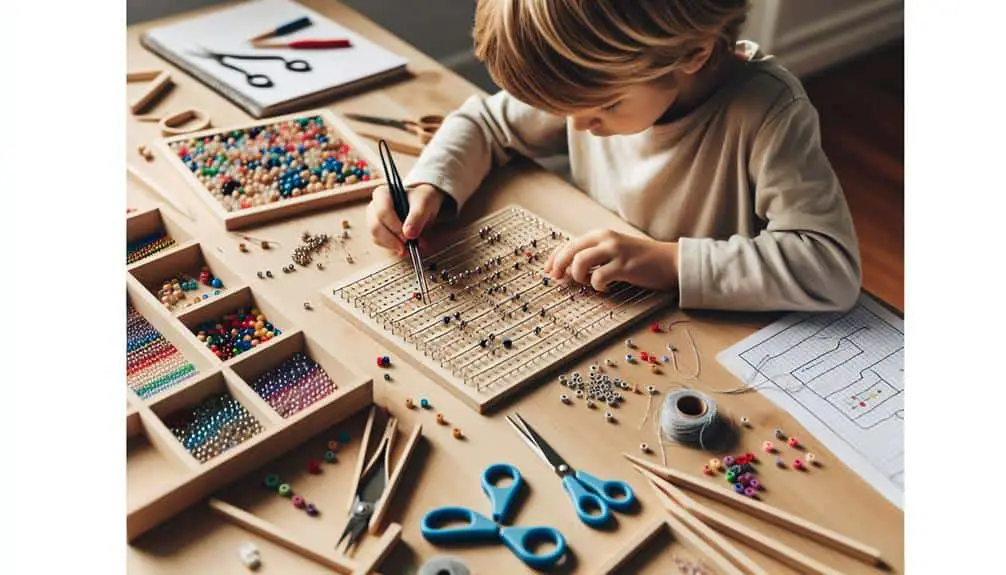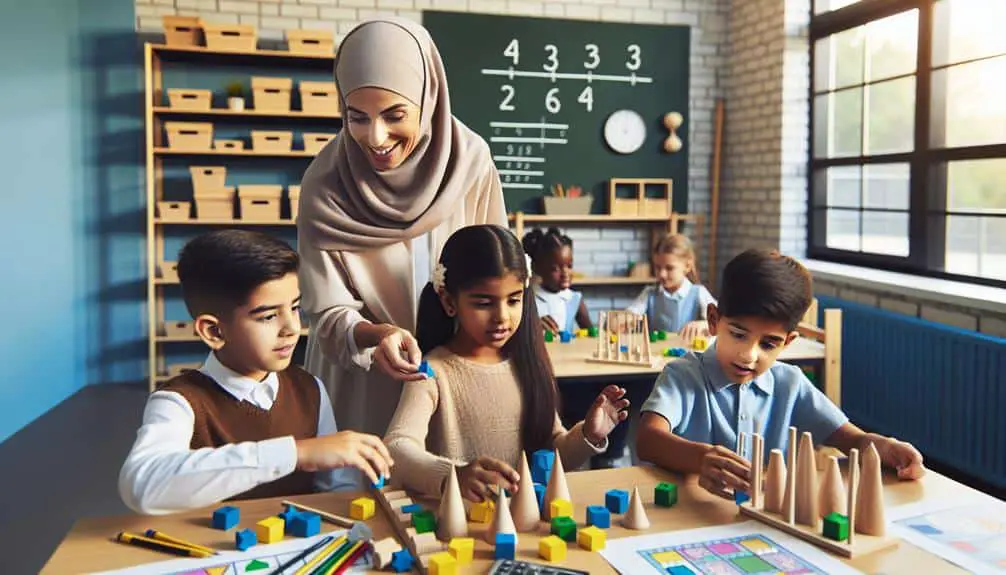Improving fine motor skills in special needs homeschooling involves tailored approaches. Conduct assessments to track progress and celebrate victories. Tailor activities focusing on individual strengths, utilizing adaptive equipment when needed. Incorporate visual tracking exercises and play-based learning for engagement. Utilize adaptive tools like grips, seek OT recommendations, and integrate tools into daily routines. Encourage outdoor play for skill development. Monitor progress closely, set goals, and adjust strategies as needed to support growth. Explore strategies and techniques to enhance fine motor skills effectively.
Key Points
- Tailored activities focus on individual abilities and target specific finger movements for skill enhancement.
- Utilize adaptive equipment like grips on pencils and scissors for improved manipulation.
- Engage in visual tracking exercises with games and tools to enhance coordination.
- Incorporate play-based learning such as molding clay and outdoor activities for skill development.
- Track progress, adjust approaches, and celebrate milestones to monitor and encourage improvement.
Fine Motor Skills Assessment
When evaluating fine motor skills in special needs homeschooling, it's important to observe how your child manipulates objects and performs tasks that involve precise movements. Skill development in this area is essential for daily activities like writing, feeding oneself, or buttoning a shirt. By conducting a thorough task analysis, you can identify specific areas where your child may be struggling and track their progress effectively.
To begin, observe how your child grasps objects, uses utensils, or handles small items. Note any difficulties they may have with hand-eye coordination or finger dexterity. This detailed observation will help in planning interventions tailored to their needs. Remember, every child is unique, and what works for one may not work for another.
Progress tracking is important to make sure that the interventions put in place are effective. Keep a record of your child's development in fine motor skills, noting any improvements or setbacks. This information will guide you in adjusting your intervention planning as needed to support your child's growth in this area.
Tailored Activities and Exercises
When considering tailored activities and exercises for fine motor skills in special needs homeschooling, it's essential to focus on individualized task selection. By targeting specific finger movements, you can help enhance coordination and dexterity.
Additionally, utilizing adaptive equipment can further support these efforts and make the learning process more accessible and engaging.
Individualized Task Selection
Selecting tailored activities and exercises based on individual needs is essential in developing fine motor skills in special needs homeschooling. When creating customized plans for your child, consider skill-building activities that target their specific areas of improvement. Personalized task selection allows you to focus on activities that are both engaging and beneficial for your child's development.
To start, observe your child's strengths and weaknesses to identify areas that require improvement. Tailor activities to suit their abilities while still providing a challenge. Progress tracking is vital in special needs homeschooling, as it allows you to monitor improvements and adjust tasks accordingly. Utilize tools such as progress journals or checklists to keep track of your child's development over time.
Remember to celebrate small victories along the way. Encouragement and positive reinforcement play a significant role in motivating your child to continue working on their fine motor skills. By selecting tasks that are tailored to your child's needs and tracking their progress, you can create a supportive learning environment that fosters growth and development.
Targeted Finger Movements
Tailor activities and exercises focusing on targeted finger movements to enhance fine motor skills in special needs homeschooling. Developing finger isolation and hand-eye coordination is essential for mastering fine motor skills.
Here's how you can incorporate targeted finger movements into your homeschooling routine:
- Finger Isolation Exercises: Encourage activities that require using individual fingers, such as picking up small objects with thumb and forefinger or playing finger games like 'Itsy Bitsy Spider' to enhance control and dexterity.
- Hand-Eye Coordination Challenges: Integrate tasks that involve precision, like threading beads onto a string, completing puzzles, or playing catch with a soft ball to improve coordination between hands and eyes.
- Fine Motor Playdough Fun: Engage in playdough activities where your child can pinch, roll, and mold the dough, helping strengthen their hand muscles and enhance fine motor skills.
- Drawing and Coloring Practice: Encourage drawing and coloring activities that require intricate movements, like tracing shapes or coloring within the lines, to refine fine motor skills and hand-eye coordination.
Adaptive Equipment Usage
To further enhance your child's fine motor skills in special needs homeschooling, consider incorporating adaptive equipment usage into tailored activities and exercises.
Equipment modifications can play an important role in facilitating skill development for children with special needs. For instance, using adapted grips on pencils or utensils can assist in improving hand strength and coordination. Adaptive scissors with spring-loaded handles can aid in developing cutting skills.
When selecting adaptive equipment, make sure it's appropriate for your child's specific needs and abilities. Consult with occupational therapists or special education professionals to determine the most suitable tools for your child.
Additionally, integrating these adaptive tools into daily activities and exercises can make skill-building more engaging and effective.
Sensory Integration Techniques
As you navigate special needs homeschooling, incorporating sensory integration techniques can truly benefit your child.
Sensory play activities, proprioceptive input strategies, and visual tracking exercises can help enhance fine motor skills in a fun and engaging way.
These techniques offer valuable sensory experiences that support your child's development and learning journey.
Sensory Play Activities
Explore engaging sensory play activities to incorporate effective sensory integration techniques into your special needs homeschooling routine. Sensory exploration and messy play are crucial components in developing fine motor skills and enhancing sensory processing for children with special needs.
Here are some practical and fun sensory play activities to try with your child:
- Sensory Bins: Fill a container with materials like rice, beans, or sand for your child to dig through, scoop, and pour, stimulating tactile sensations.
- DIY Slime or Playdough: Making and playing with homemade slime or playdough can provide a calming sensory experience while also improving hand strength and coordination.
- Water Play: Water activities like pouring, squirting, and splashing help refine hand-eye coordination and encourage wrist and finger movements.
- Texture Boards: Create boards with various textures such as fur, sandpaper, or bubble wrap for your child to touch and explore, aiding sensory perception and tactile sensitivity.
Incorporating these sensory play activities into your homeschooling routine can promote sensory processing and fine motor skill development in an enjoyable and effective way.
Proprioceptive Input Strategies
Engage your child's sense of body awareness and movement by incorporating proprioceptive input strategies, important for enhancing sensory integration techniques in your special needs homeschooling routine. Sensory regulation plays a vital role in helping your child develop fine motor skills.
Through tactile input, such as deep pressure activities like hugs, weighted blankets, or pushing and pulling heavy objects, you can provide your child with the necessary input to improve body awareness. These activities can help your child better understand where their body is in space, leading to improved coordination and motor skills.
Body awareness and movement strategies are key components in sensory integration techniques. Encourage activities that involve pushing or pulling, climbing, jumping, or carrying heavy objects to stimulate your child's proprioceptive system. Simple tasks like sweeping the floor, carrying a basket of laundry, or pushing a wheelbarrow can provide valuable input for sensory processing.
Visual Tracking Exercises
Enhance your child's sensory integration skills by incorporating visual tracking exercises into your special needs homeschooling routine. Visual tracking exercises can greatly improve eye coordination and hand control, benefiting skills like visual perception and hand-eye coordination.
Here are four engaging visual tracking exercises to try with your child:
- Tracking Games: Use toys or objects that move slowly and steadily to encourage your child to visually track the item's movement with their eyes and then reach out to touch it.
- Obstacle Courses: Create obstacle courses with colorful markers or objects placed at varying distances. Have your child navigate the course while focusing on tracking and reaching for specific items.
- Follow the Light: Use a flashlight or a laser pointer to create moving light patterns on the wall. Encourage your child to track the light's path using their eyes and reaching out to touch specific points.
- Eye Tracking Worksheets: Printable worksheets with mazes, dot-to-dot activities, or tracing exercises can help improve visual tracking skills and hand-eye coordination in a fun and educational way.
These exercises can make learning enjoyable while enhancing your child's visual tracking abilities.
Adaptive Tools and Equipment
When considering adaptive tools and equipment for fine motor skills development in special needs homeschooling, it's important to prioritize practicality and effectiveness over significance.
Customized adaptations and innovative solutions play a vital role in assisting individuals with special needs. These adaptations can range from simple tools like pencil grips to more complex assistive technology devices tailored to specific needs. Creative modifications to everyday items can also make a significant difference in enhancing fine motor skills.
Assistive technology, such as specialized keyboards or adaptive utensils, can facilitate independent learning and skill development. By incorporating these tools into your homeschooling routine, you can create a supportive environment that fosters growth and confidence.
Seek out resources and professionals who can help you identify the most suitable adaptive tools for your child's unique requirements.
Incorporating Play for Learning
Consider incorporating interactive games and activities to promote learning and skill development in your special needs homeschooling routine. Play-based learning and creative exploration can be powerful tools in enhancing fine motor skills.
Here are some practical ways to incorporate play for learning:
- Hands-On Activities: Engage your child in activities like molding clay, stringing beads, or playing with building blocks. These activities help improve hand-eye coordination and fine motor control.
- Sensory Engagement: Create sensory bins with materials like rice, sand, or water for your child to explore using their hands. Sensory play can enhance tactile sensitivity and fine motor skills.
- Interactive Games: Incorporate educational games that require fine motor skills, such as puzzles, board games, or card games. These games can help improve dexterity and hand strength.
- Outdoor Play: Encourage outdoor activities like playing catch, using chalk to draw on the sidewalk, or gardening. Outdoor play promotes gross and fine motor skill development while providing sensory stimulation.
Tracking Progress and Adjusting Approaches
To effectively support your child's development, it's important to track progress regularly and adjust your approaches as needed in your special needs homeschooling journey.
Progress monitoring is essential in understanding how your child is responding to the interventions and activities you have put in place. Keep a journal or use apps to document improvements, challenges, and any changes you observe in their fine motor skills. This tracking will provide valuable insights for making intervention adjustments.
When tracking progress, focus on specific skill development and goal setting. Set realistic and achievable goals for your child's fine motor skill enhancement. Regularly reassess these goals based on the progress your child is making.
If you notice that certain activities aren't yielding the desired results, don't hesitate to adjust your approaches. Be flexible and open to trying new strategies that might better support your child's development.
Frequently Asked Questions
Can I Incorporate Fine Motor Skills Practice Into Daily Routines?
You can incorporate fine motor skills practice into daily routines easily. From art projects to meal prep, chores to outdoor play, there are many fun and practical ways to improve these skills without it feeling like work.
How Can I Make Fine Motor Activities More Engaging?
If you want to make fine motor activities more engaging, try incorporating sensory play to stimulate their senses and spark interest. Art projects can also be a fun way to boost creativity while working on dexterity skills.
Are There Specific Tools for Children With Sensory Sensitivities?
When children have sensory sensitivities, using sensory-friendly tools and tactile adaptations can make a big difference. Look for tools that are gentle on the senses and consider incorporating modifications for a more comfortable learning experience.
What Are Some Creative Ways to Encourage Play-Based Learning?
You might be surprised to know that 80% of brain development occurs by age 3. To encourage play-based learning, try sensory play with textures, developmental toys, art exploration, and outdoor activities. These methods can foster creativity and skill development.
How Often Should I Reassess My Child's Progress in Fine Motor Skills?
To guarantee your child's development, reassess their progress in fine motor skills regularly. Check in on their milestones and benchmarks frequently. By evaluating their progress often, you can adjust activities and support to meet their needs effectively.



